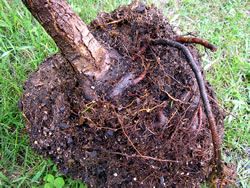To
Amend or Not To Amend, that is the question
 |
| Cornus kousa |
Although
some property managers and HOA Reps may wish to resort to the heavy use of soil
amendments to ‘improve’ the native soil, our experience agrees with the horticulture
specialists at the University of Georgia
Extension Service and experts across the U.S., who do NOT recommend heavily amending individual planting
holes.
Research
has shown there are 2 reasons that plants in individually-amended planting holes do worse:
 |
| girdling roots |
Reason 1: if the back fill soil has a lot of pine bark or compost added to a
moderate-sized planting hole, the newly planted shrub follows the path of least
resistance. Instead of the roots growing straight out of the dug hole and into the
surrounding soil in all directions, they continue to circle around and around
in the “fluffy soil” inside the planting hole. To my mind, the roots never
achieve the "jump to hyperspeed” (like the Millenium Falcon in Star Wars) and
are contained inside the hole.
What results is a restricted, circular root
system that remains confined to the limited extent of the planting hole and can eventually girdle the trunk, killing the plant. Even
though planted in open ground, the plant effectively becomes “pot bound” and is
more sensitive to both drought and excess rainfall.
Reason 2: excessive soil amendments added to a small area upset the moisture balance
between the planting hole and the surrounding soil. Roots need oxygen too! In a
wet year the organic amendments soak up and retain water like a sponge in the planting
hole, absorbing and holding too much moisture and causing “wet feet” as when the
roots to stay too wet and rot or drown without oxygen. This is known as the "bathtub effect".
 |
| prepared flower bed |
Entire
Flower Beds, Lawns or Gardens
Now,
these soil amendment considerations do not apply when Crabapple prepares annual
beds, an entire lawn or a complete garden area, but only when individual holes
are dug for woody ornamentals and trees. In the case of entire beds, there is
no problem with water relations or moisture balance in the root zone of the
plants because they experience uniform conditions.
 |
| Diagram courtesy of the City of Bowling Green, KY |
LandscapExperts
Best Practices
Optimal
growth is achieved when a large, wide (but not deep) planting hole is dug, and
the backfill soil is well worked and aerated. Our planting holes are two or three
times the diameter of the container or root ball, and we take care that the top
of the roots are level with the soil surface and not sunken. We backfill with
the same soil removed from the hole but only after breaking apart clods,
removing stones and debris, and smoothing out the texture. Slopes and drainage
are also considered. In compacted clay soils a large planting hole with loose
backfill soil is essential for proper plant establishment.
Finishing
Touches

















